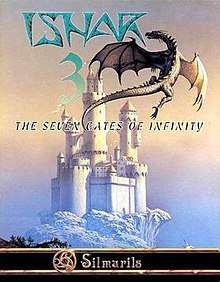Ishar 3: The Seven Gates of Infinity
Ishar 3: The Seven Gates of Infinity is a 1994 role-playing video game developed and published by Silmarils. It is part of the Ishar series of games, and a sequel to Ishar 2: Messengers of Doom.
| Ishar 3: The Seven Gates of Infinity | |
|---|---|
 | |
| Developer(s) | Silmarils |
| Publisher(s) | Silmarils
|
| Designer(s) | Michel Pernot Pascal Einsweiler |
| Programmer(s) | Jean-François Trevien Louis-Marie Rocques |
| Artist(s) | Eric Galand Guillaume Maginot |
| Composer(s) | Fabrice Hautecloque |
| Series | Ishar |
| Engine | ALIS[lower-alpha 1] |
| Platform(s) | Amiga, Atari Falcon, Atari ST, Macintosh, MS-DOS, Microsoft Windows |
| Release | |
| Genre(s) | Role-playing game |
| Mode(s) | Single-player |
Gameplay
The player takes the role of Zubaran (or imports a party of characters from another game in the series), and is tasked with hunting the dragon Sith. To this end, the player must cross a series of gates that lead to different time periods. Each period, like the islands of Ishar 2, has its own climate and type of landscape.
Release
Cyril Cogordan, a former Silmarils programmer, has stated in an interview and on his personal website that a conversion of Ishar 3 was in development for the Atari Jaguar CD, based upon the CD-ROM version released for the Atari Falcon. Despite being completed and sent to Atari Corporation for approval, it was never released due to Atari Corp. closing their doors as a result of the commercial and critical failure of the Atari Jaguar platform.[3][4][5][6]
Reception
| Reception | ||||||||||||||
|---|---|---|---|---|---|---|---|---|---|---|---|---|---|---|
| ||||||||||||||
Reviewing Ishar 3 for PC Gamer US, William R. Trotter wrote, "Hardcore FRPG fans will probably like it—novices will find it tedious, overwhelming, and frustrating." He called the graphics "often breathtakingly beautiful" and "as richly textured as oil paintings", but found the game's reliance on backtracking dull and disliked the high speed of combat.[8]
In CU Amiga, Toby Dillon called Ishar 3 "almost the perfect RPG." He concluded, "All of the right elements from the last two games have been kept, the plot has been improved and the game looks simply incredible."[9] Tina Hackett of Amiga Computing called Ishar 3 "one of the most absorbing and atmospheric adventures around", despite her minor criticisms of its sound. She praised its depth of content and characterization, and considered it "a superb addition to the Ishar series".[10]
Next Generation reviewed the PC version of the game, rating it two stars out of five, and stated that "This is Bard's Tale all over again."[7]
Notes
References
- Moreau, Frédéric. "Interview de Cyril Cogordan programmeur de Ishar 3 et Robinson 's Requiem". jaguar-64bit.pagesperso-orange.fr (in French). Archived from the original on 2018-02-16. Retrieved 2018-09-24.
Cyril Cogordan: La premiere étape pour moi a été d'adapter le moteur "Alis" de Silmarils sur la Jaguar pour pouvoir faire tourner une preview rapide du jeu.
- Wasabim (October 7, 2017). "INTERVIEWS - Fabrice Hautecloque". atarilegend.com. Archived from the original on 2018-09-24. Retrieved 2018-09-24.
Fabrice Hautecloque: "Silmarils" used a cross-platform game engine called ALIS (Actor Language Integrated System from memory).
- "Atari and JT Storage Reorganisation Plan". onecle.com. Archived from the original on December 9, 2006. Retrieved 2018-09-24.
- "ATARI CORP Annual Report (Regulation S-K, item 405) (10-K405) ITEM 7. MANAGEMENT'S DISCUSSION AND ANALYSIS OF FINANCIAL CONDITION AND RESULTS OF OPERATIONS". Archived from the original on 2018-06-12. Retrieved 2018-09-24.
- Moreau, Frédéric. "Interview de Cyril Cogordan programmeur de Ishar 3 et Robinson 's Requiem". jaguar-64bit.pagesperso-orange.fr (in French). Archived from the original on 2018-02-16. Retrieved 2018-09-23.
- Cogordan, Cyril. "Qui est Foxy ?". foxysofts.com (in French). Archived from the original on 2018-03-20. Retrieved 2018-09-23.
- "Finals". Next Generation. No. 2. Imagine Media. February 1995. p. 94.
- Trotter, William R. (March 1995). "Ishar 3: The Seven Gates of Infinity". PC Gamer US. 2 (3): 103.
- Dillon, Toby (August 1994). "Ishar 3". CU Amiga (54): 66, 67.
- Hackett, Tina (November 1994). "Ishar 3". Amiga Computing (79): 100, 101.
- Snyder, Frank; Chapman, Ted; Kaiafas, Tasos (September 1995). "The Final Episode". Computer Game Review. Archived from the original on 1996-12-21. Retrieved 2019-01-05.CS1 maint: uses authors parameter (link)